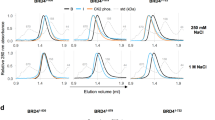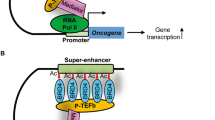Abstract
Acetylation of the RelA subunit of NF-κB at lysine-310 regulates the transcriptional activation of NF-κB target genes and contributes to maintaining constitutively active NF-κB in tumors. Bromodomain-containing factor Brd4 has been shown to bind to acetylated lysine-310 (AcLys310) and to regulate the transcriptional activity of NF-κB, but the role of this binding in maintaining constitutively active NF-κB in tumors remains elusive. In this study, we demonstrate the structural basis for the binding of bromodomains (BDs) of bromodomain-containing protein 4 (Brd4) to AcLys310 and identify the BD inhibitor JQ1 as an effective small molecule to block this interaction. JQ1 suppresses TNF-α-mediated NF-κB activation and NF-κB-dependent target gene expression. In addition, JQ1 inhibits the proliferation and transformation potential of A549 lung cancer cells and suppresses the tumorigenicity of A549 cells in severe combined immunodeficiency mice. Furthermore, we demonstrate that depletion of Brd4 or treatment of cells with JQ1 induces the ubiquitination and degradation of the constitutively active nuclear form of RelA. Our results identify a novel function of Brd4 in maintaining the persistently active form of NF-κB found in tumors, and they suggest that interference with the interaction between acetylated RelA and Brd4 could be a potential therapeutic approach for the treatment of NF-κB-driven cancer.
This is a preview of subscription content, access via your institution
Access options
Subscribe to this journal
Receive 50 print issues and online access
$259.00 per year
only $5.18 per issue
Buy this article
- Purchase on Springer Link
- Instant access to full article PDF
Prices may be subject to local taxes which are calculated during checkout





Similar content being viewed by others
References
Ghosh S, Karin M . Missing pieces in the NF-kappaB puzzle. Cell 2002; 109: S81–S96.
Ghosh S, May MJ, Kopp EB . NF-κB and Rel proteins: evolutionarily conserved mediators of immune responses. Annu Rev Immunol 1998; 16: 225–260.
Baldwin AS Jr . The NF-kappa B and I kappa B proteins: new discoveries and insights. Annu Rev Immunol 1996; 14: 649–683.
Karin M, Cao Y, Greten FR, Li ZW . NF-kappaB in cancer: from innocent bystander to major culprit. Nat Rev Cancer 2002; 2: 301–310.
Karin M, Greten FR . NF-kappaB: linking inflammation and immunity to cancer development and progression. Nat Rev Immunol 2005; 5: 749–759.
Basseres DS, Baldwin AS . Nuclear factor-kappaB and inhibitor of kappaB kinase pathways in oncogenic initiation and progression. Oncogene 2006; 25: 6817–6830.
Baud V, Karin M . Is NF-kappaB a good target for cancer therapy? Hopes and pitfalls. Nat Rev Drug Discov 2009; 8: 33–40.
Aggarwal BB . Nuclear factor-kappaB: the enemy within. Cancer Cell 2004; 6: 203–208.
Chaturvedi MM, Sung B, Yadav VR, Kannappan R, Aggarwal BB . NF-kappaB addiction and its role in cancer: ‘one size does not fit all’. Oncogene 2011; 30: 1615–1630.
Karin M . Nuclear factor-kappaB in cancer development and progression. Nature 2006; 441: 431–436.
Perkins ND . The diverse and complex roles of NF-kappaB subunits in cancer. Nat Rev Cancer 2012; 12: 121–132.
Baylin SB, Jones PA . A decade of exploring the cancer epigenome: biological and translational implications. Nat Rev Cancer 2011; 11: 726–734.
Sims RJ 3rd, Reinberg D . Is there a code embedded in proteins that is based on post-translational modifications? Nat Rev Mol Cell Biol 2008; 9: 815–820.
Perkins ND . Post-translational modifications regulating the activity and function of the nuclear factor kappa B pathway. Oncogene 2006; 25: 6717–6730.
Huang B, Yang XD, Lamb A, Chen LF . Post-translational modifications of NF-kappaB: another layer of regulation for NF-kappaB signaling pathway. Cell Signal 2010; 22: 1282–1290.
Chen LF, Greene WC . Shaping the nuclear action of NF-κB. Nat Rev Mol Cell Biol 2004; 5: 392–401.
Chen LF, Mu Y, Greene WC . Acetylation of RelA at discrete sites regulates distinct nuclear functions of NF-κB. EMBO J 2002; 21: 6539–6548.
Yeung F, Hoberg JE, Ramsey CS, Keller MD, Jones DR, Frye RA et al. Modulation of NF-kappaB-dependent transcription and cell survival by the SIRT1 deacetylase. EMBO J 2004; 23: 2369–2380.
Lee H, Herrmann A, Deng JH, Kujawski M, Niu G, Li Z et al. Persistently activated Stat3 maintains constitutive NF-kappaB activity in tumors. Cancer Cell 2009; 15: 283–293.
Dai Y, Rahmani M, Dent P, Grant S . Blockade of histone deacetylase inhibitor-induced RelA/p65 acetylation and NF-kappaB activation potentiates apoptosis in leukemia cells through a process mediated by oxidative damage, XIAP downregulation, and c-Jun N-terminal kinase 1 activation. Mol Cell Biol 2005; 25: 5429–5444.
Huang B, Yang XD, Zhou MM, Ozato K, Chen LF . Brd4 coactivates transcriptional activation of NF-kappaB via specific binding to acetylated RelA. Mol Cell Biol 2009; 29: 1375–1387.
Jeanmougin F, Wurtz JM, Le Douarin B, Chambon P, Losson R . The bromodomain revisited. Trends Biochem Sci 1997; 22: 151–153.
Wu SY, Chiang CM . The double bromodomain-containing chromatin adaptor Brd4 and transcriptional regulation. J Biol Chem 2007; 282: 13141–13145.
Chiang CM . Brd4 engagement from chromatin targeting to transcriptional regulation: selective contact with acetylated histone H3 and H4. F1000 Biol Rep 2009; 1: 98.
You J, Croyle JL, Nishimura A, Ozato K, Howley PM . Interaction of the bovine papillomavirus E2 protein with Brd4 tethers the viral DNA to host mitotic chromosomes. Cell 2004; 117: 349–360.
Maruyama T, Farina A, Dey A, Cheong J, Bermudez VP, Tamura T et al. A mammalian bromodomain protein, Brd4, interacts with replication factor C and inhibits progression to S phase. Mol Cell Biol 2002; 22: 6509–6520.
Jiang YW, Veschambre P, Erdjument-Bromage H, Tempst P, Conaway JW, Conaway RC et al. Mammalian mediator of transcriptional regulation and its possible role as an end-point of signal transduction pathways. Proc Natl Acad Sci USA 1998; 95: 8538–8543.
French CA . Pathogenesis of NUT midline carcinoma. Annu Rev Pathol 2012; 7: 247–265.
Zuber J, Shi J, Wang E, Rappaport AR, Herrmann H, Sison EA et al. RNAi screen identifies Brd4 as a therapeutic target in acute myeloid leukaemia. Nature 2011; 478: 524–528.
Filippakopoulos P, Qi J, Picaud S, Shen Y, Smith WB, Fedorov O et al. Selective inhibition of BET bromodomains. Nature 2011; 468: 1067–1073.
Delmore JE, Issa GC, Lemieux ME, Rahl PB, Shi J, Jacobs HM et al. BET bromodomain inhibition as a therapeutic strategy to target c-Myc. Cell 2011; 146: 904–917.
Nicodeme E, Jeffrey KL, Schaefer U, Beinke S, Dewell S, Chung CW et al. Suppression of inflammation by a synthetic histone mimic. Nature 2010; 468: 1119–1123.
Chung CW . Small molecule bromodomain inhibitors: extending the druggable genome. Prog Med Chem 2012; 51: 1–55.
Mertz JA, Conery AR, Bryant BM, Sandy P, Balasubramanian S, Mele DA et al. Targeting Myc dependence in cancer by inhibiting BET bromodomains. Proc Natl Acad Sci USA 2011; 108: 16669–16674.
Karin M, Liu Z, Zandi E . AP-1 function and regulation. Curr Opin Cell Biol 1997; 9: 240–246.
Choi KC, Lee YH, Jung MG, Kwon SH, Kim MJ, Jun WJ et al. Gallic acid suppresses lipopolysaccharide-induced nuclear factor-kappaB signaling by preventing RelA acetylation in A549 lung cancer cells. Mol Cancer Res 2009; 7: 2011–2021.
Ishinaga H, Jono H, Lim JH, Kweon SM, Xu H, Ha UH et al. TGF-beta induces p65 acetylation to enhance bacteria-induced NF-kappaB activation. EMBO J 2007; 26: 1150–1162.
Adcock IM, Tsaprouni L, Bhavsar P, Ito K . Epigenetic regulation of airway inflammation. Curr Opin Immunol 2007; 19: 694–700.
Gupta SC, Sundaram C, Reuter S, Aggarwal BB . Inhibiting NF-kappaB activation by small molecules as a therapeutic strategy. Biochim Biophys Acta 2010; 1799: 775–787.
Belkina AC, Denis GV . BET domain co-regulators in obesity, inflammation and cancer. Nat Rev Cancer 2012; 12: 465–477.
Oliver SS, Denu JM . Disrupting the reader of histone language. Angew Chem Int Ed Engl 2011; 50: 5801–5803.
Zhang G, Liu R, Zhong Y, Plotnikov AN, Zhang W, Zeng L et al. Down-regulation of NF-kappaB transcriptional activity in HIV-associated kidney disease by BRD4 inhibition. J Biol Chem 2012; 287: 28840–28851.
Yang XD, Tajkhorshid E, Chen LF . Functional interplay between acetylation and methylation of the RelA subunit of NF-kappaB. Mol Cell Biol 2010; 30: 2170–2180.
Yang XD, Huang B, Li M, Lamb A, Kelleher NL, Chen LF . Negative regulation of NF-kappaB action by Set9-mediated lysine methylation of the RelA subunit. EMBO J 2009; 28: 1055–1066.
Zheng G, Schweiger MR, Martinez-Noel G, Zheng L, Smith JA, Harper JW et al. Brd4 regulation of papillomavirus protein E2 stability. J Virol 2009; 83: 8683–8692.
Lee AY, Chiang CM . Chromatin adaptor Brd4 modulates E2 transcription activity and protein stability. J Biol Chem 2009; 284: 2778–2786.
Jang MK, Kwon D, McBride AA . Papillomavirus E2 proteins and the host BRD4 protein associate with transcriptionally active cellular chromatin. J Virol 2009; 83: 2592–2600.
Saccani S, Marazzi I, Beg AA, Natoli G . Degradation of promoter-bound p65/RelA is essential for the prompt termination of the nuclear factor kappaB response. J Exp Med 2004; 200: 107–113.
Sen R, Smale ST . Selectivity of the NF-{kappa}B response. Cold Spring Harb Perspect Biol 2010; 2: a000257.
Chen LF, Williams SA, Mu Y, Nakano H, Duerr JM, Buckbinder L et al. NF-kappaB RelA phosphorylation regulates RelA acetylation. Mol Cell Biol 2005; 25: 7966–7975.
Huang B, Qu Z, Ong CW, Tsang YH, Xiao G, Shapiro D et al. RUNX3 acts as a tumor suppressor in breast cancer by targeting estrogen receptor alpha. Oncogene 2012; 31: 527–534.
Acknowledgements
We thank members in the Chen lab for discussion and A Lamb for assistance in the preparation of the manuscript. This work is supported in part by funds provided by UIUC (to LFC) and NIH grants DK-085158 (to LFC).
Author information
Authors and Affiliations
Corresponding author
Ethics declarations
Competing interests
The authors declare no conflict of interest.
Additional information
Supplementary Information accompanies this paper on the Oncogene website
Supplementary information
Rights and permissions
About this article
Cite this article
Zou, Z., Huang, B., Wu, X. et al. Brd4 maintains constitutively active NF-κB in cancer cells by binding to acetylated RelA. Oncogene 33, 2395–2404 (2014). https://doi.org/10.1038/onc.2013.179
Received:
Revised:
Accepted:
Published:
Issue Date:
DOI: https://doi.org/10.1038/onc.2013.179
Keywords
This article is cited by
-
Differential responses of pulmonary vascular cells from PAH patients and controls to TNFα and the effect of the BET inhibitor JQ1
Respiratory Research (2023)
-
TNFα-induced IDH1 hyperacetylation reprograms redox homeostasis and promotes the chemotherapeutic sensitivity
Oncogene (2023)
-
Bromodomain and extraterminal (BET) proteins: biological functions, diseases, and targeted therapy
Signal Transduction and Targeted Therapy (2023)
-
Combinatorial inhibition of BTK, PI3K-AKT and BRD4-MYC as a strategy for treatment of mantle cell lymphoma
Molecular Biomedicine (2022)
-
The BET family in immunity and disease
Signal Transduction and Targeted Therapy (2021)



